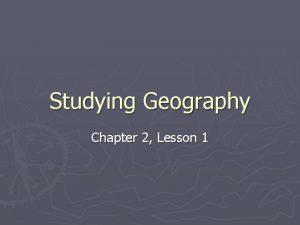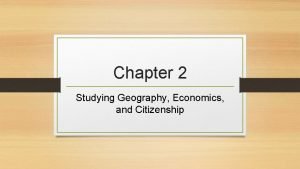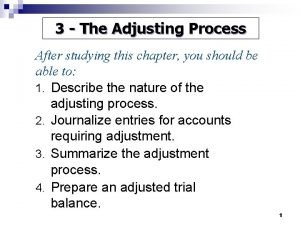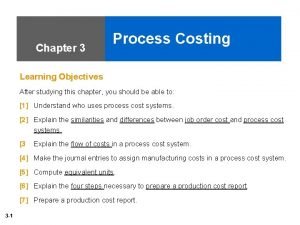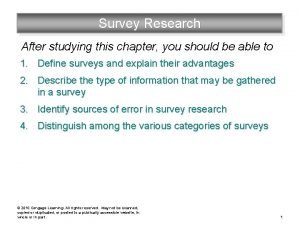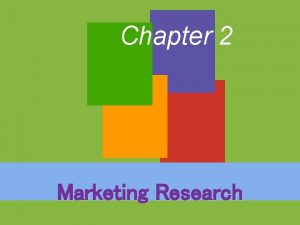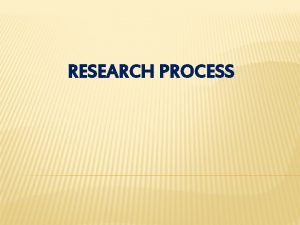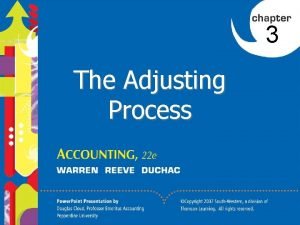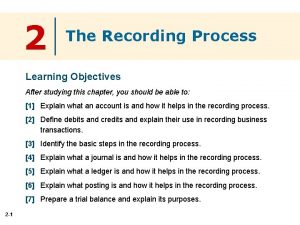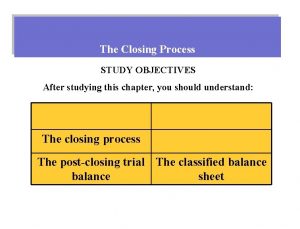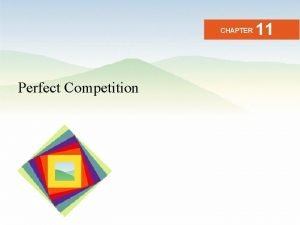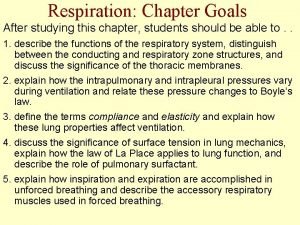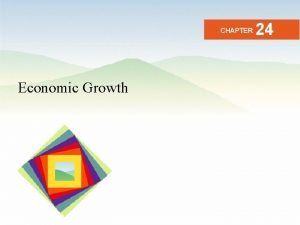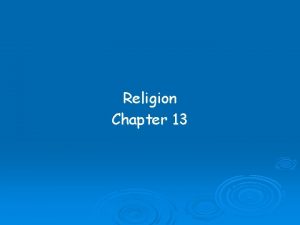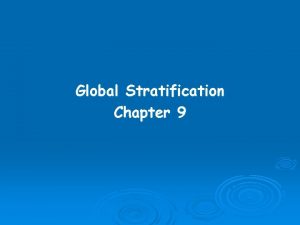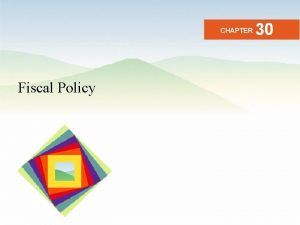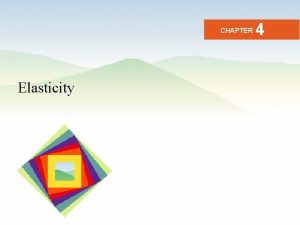The Research Process Chapter 2 After studying this




































- Slides: 36

The Research Process Chapter 2

After studying this chapter, you should be able to do the following: Ø Ø Ø Ø Ø Explain the steps in the sociological research process. Analyze the strengths and weaknesses of the various research designs. Know what independent and dependent variables are. Know what sampling is and how to create a representative sample. Recognize researcher bias and how it can invalidate a study. Explain the strengths and weaknesses of the various measures of central tendency. Read and understand the contents of a table. Explain the concepts of reliability and validity. Understand the problems of objectivity and ethical issues that arise in sociological research.

Two main goals that assist with approaching a study scientifically significantly Ø Describe in detail particular things and events Ø Propose and test theories that help understand things are events

Research Process Ø Involves the following: l l l l Defining a problem Reviewing previous research on the topic Developing one or more hypotheses Determining the research design Defining the sample and collecting data Analyzing and interpreting data Preparing the research report

Table 2 -1 The Research Process Steps in the Process Typical Questions Define the problem What is the purpose of the study? What information is needed? How can we operationalize the terms? How will the information be used? Review previous research What studies have already been done on this topic? Do we need additional information before we begin? From what perspective should we approach this issue? Develop one or more hypotheses variables? What are the independent and dependent What is the relationship among the variables? What types of questions do we need to answer? Determine the research design Can we use existing data? What will we measure or observe? What research methods should we use? Define the sample and collect data Are we interested in a specific population? How large should the sample be? Who will gather the data? How long will it take? Analyze the data and draw conclusions Prepare the research report What statistical techniques will we use? Have our hypotheses been proved or disproved? Is our information valid and reliable? What are the implications of our study? Who will read the report? What is their level of familiarity with the subject? How should we structure the report?

Step 1: Define the Problem Two types of questions that will assist with defining the problem Empirical Ex: How many students in this class have an A? Operational Ex: What are some features of love?

Empirical Question Ø A question that can be answered by observing and analyzing the world as it is known

Operational definition l A definition of an abstract concept in terms of the observable features that describe thing being investigated

Step 2: Review Previous Research By knowing as much possible about research, we avoid duplicating a previous study and are able to build on contributions others have made to the understanding of the topic.

Step 3: Develop One of More Hypotheses Ø Hypotheses l A testable statement about the relationship between two or more variables. Ø Variable l Anything that can change (vary) • Example: l l Income Death rate

Two different kinds of variables: Ø Independent l Ø Causes or changes another variable Dependent l l Is influenced by the independent variable Ex. : Men who live in cities (independent variable) are more likely to marry (independent variable) young than are men who live in the country.

Ø A hypotheses may involve two types of statements: l l Statement of causality Statement of association

Ø Statement of Causality l Says that something brings about, influences, or changes something else. • Ex: Love between man and woman always produces marriage.

Ø Statement of association l Says that changes in one thing are related to changes in another but one does not necessarily cause the other. • Ex. Therefore, if we propose that “the greater the love relationship between a man and a woman, then the more likely it is they will marry, ” we are making a statement of association. We are noting a connection between love and marriage, but also that one does not necessarily cause the other.

Write a hypotheses and identify your independent and dependent variable?

Step 4: Determine the research design Ø There are four main methods of research used by sociologist: l l Survey Participant observation Experiment Secondary Analysis

Survey Ø Is a research method in a population or a portion thereof, is questioned in order to reveal specific facts about itself. Surveys can be used to conduct two type of studies: l Cross-sectional study • Research across a population at a given time. l Longitudinal research • Research that investigates a population over a period of time.

Interviews Ø Consists of a conversation between two more individuals in which one party attempts to gain information from the other by asking questions. Types of interviews Ø Structured l Ø A research interview entirely predetermined by questionnaire that is followed rigidly Semi-structured l Research in which the investigator asks a list of questions but is free to vary them or even to make up new questions on topics that can take an importance in the course of the interview.

Participant Observation Ø Researchers entering into a group’s activities and observing the group members.

Experiment Ø An investigation in which the variables being studied are controlled and the researcher obtains the results through precise observation and measurement.

Secondary Analysis Ø The process of making use of data that has been collected by others.

Table 2 -2 The Advantages and Disadvantages of Various Research Method Advantages Disadvantages Large numbers of people can be surveyed with questionnaires. Data can be quantified and comparisons among groups can be made. Measures can be taken at different points. Respondents may give false information or responses they think the researcher wants to hear. Surveys do not leave room for answers that may not fit the standardized categories. There may be a low response rate. Allows people to be observed in their “natural” environments. Provides a more in-depth under standing of the people being studied. Hypotheses and theories can be developed and changed as the research progresses. Findings are open to interpretation and subject to researcher bias. The researcher may have an unintended influence on the subjects. It is time consuming. The results may be difficult to replicate. Experiment Variables can be isolated and controlled. A cause-and-effect relationship can be found. Easy to replicate The laboratory setting creates an artificial social environment. The study has to be limited to a few variables. Most things sociologists investigate cannot be studied in a laboratory. Secondary analysis Useful for collecting or analyzing historical and longitudinal data. Saves time and money involved in doing a new study. The data may be flawed. Data may not be suitable for the current study. Social survey Participant observation

Step 5: Define Sample and Collect Data Ø The particular subset of the population chosen for the study is called sample. Ø The failure to achieve a representative sample is called sampling error. Sampling Ø A research technique through which investigators study a manageable number of people, known as the sample, selected from a larger population or group.

Two types of sample Ø Random l To select subjects so that each individual in the population has an equal chance of being chosen. Ø Stratified l The method used to prevent certain groups from being under- or overrepresented.

Ø Research Bias l The tendency for researchers to select data that support, and to ignore data that seem to go against, their hypotheses.

How to deal with research bias? Ø Use a blind investigators, or investigators who do not know whether a specific subject belongs to the group of actual cases being investigated or to a comparison group. Ø Double-blind investigators are kept uninformed not only of the kinds of subjects (case subjects or comparison group subjects) they are studying but also of the hypotheses being tested.

Step 6: Analyze the Data and Draw a Conclusion Analysis Ø Is the process through which large and complicated collections of scientific data are organized so that comparisons can be made and conclusions drawn.

The three measures of central tendency l l l Mean-average Median falls midway in the series of numbers Mode-the number that occurs often in the data

Studies must show validity and reliability

Validity l The study must actually test what it was intended to test Reliability l The findings of the study must be repeatable.

Step 7: Prepare the Research Report Researchers generally publish their findings in scientific journals.

Objectivity in Sociological Research Ø Three influential factors listed by Gunnar (1969) that assist with imposing value on research: l l l The scientific tradition within which the scientist is educated; The cultural, social, economic, and political environment within which the scientist is trained and engages in research The scientist’s own temperament, inclinations, interests, concerns, and experiences.

Ø Gunnar Myrdal (1969) lists three such influential factors: l l l the scientific tradition within which the scientist is educated; the cultural, social, economic, and political environment within which the scientist is trained and engages in research; and the scientist’s own temperament, inclinations, interests, concerns, and experiences.

Ethical Issues in Sociological Research Fundamental questions. l l l Whose interests are served by the research? Who will benefit from it? How might people be hurt? To what degree do subjects have the right to be told about the research design, its purposes, and possible applications? Who should have access to and control over research data after a study is completed—the agency that funded the study, the scientists, the subjects? Should research subjects have the right to participate in the planning of projects?

Ø Three potential dilemmas for the researcher discussed by Herbert Gans. l l l degree of “permissible risk, pain, or harm the extent to which subjects should be deceived in a study the “disclosure of confidential or personally harmful information. ”

It is useful for human beings to seek to understand themselves and the social world in which they live. Sociology has a great contribution to make to this endeavor, both in promoting understanding for its own sake and in providing social planners with scientific information with which well-founded decisions can be made and sound plans for future development adopted.
 After me after me after me
After me after me after me If any man will come after me
If any man will come after me Chapter 24 studying the sun
Chapter 24 studying the sun Lesson 1 studying geography
Lesson 1 studying geography Chapter 2 lesson 1 studying geography
Chapter 2 lesson 1 studying geography Hình ảnh bộ gõ cơ thể búng tay
Hình ảnh bộ gõ cơ thể búng tay Ng-html
Ng-html Bổ thể
Bổ thể Tỉ lệ cơ thể trẻ em
Tỉ lệ cơ thể trẻ em Voi kéo gỗ như thế nào
Voi kéo gỗ như thế nào Tư thế worm breton
Tư thế worm breton Chúa yêu trần thế
Chúa yêu trần thế Các môn thể thao bắt đầu bằng tiếng nhảy
Các môn thể thao bắt đầu bằng tiếng nhảy Thế nào là hệ số cao nhất
Thế nào là hệ số cao nhất Các châu lục và đại dương trên thế giới
Các châu lục và đại dương trên thế giới Công của trọng lực
Công của trọng lực Trời xanh đây là của chúng ta thể thơ
Trời xanh đây là của chúng ta thể thơ Mật thư anh em như thể tay chân
Mật thư anh em như thể tay chân Phép trừ bù
Phép trừ bù độ dài liên kết
độ dài liên kết Các châu lục và đại dương trên thế giới
Các châu lục và đại dương trên thế giới Thể thơ truyền thống
Thể thơ truyền thống Quá trình desamine hóa có thể tạo ra
Quá trình desamine hóa có thể tạo ra Một số thể thơ truyền thống
Một số thể thơ truyền thống Bàn tay mà dây bẩn
Bàn tay mà dây bẩn Vẽ hình chiếu vuông góc của vật thể sau
Vẽ hình chiếu vuông góc của vật thể sau Nguyên nhân của sự mỏi cơ sinh 8
Nguyên nhân của sự mỏi cơ sinh 8 đặc điểm cơ thể của người tối cổ
đặc điểm cơ thể của người tối cổ Thứ tự các dấu thăng giáng ở hóa biểu
Thứ tự các dấu thăng giáng ở hóa biểu Vẽ hình chiếu đứng bằng cạnh của vật thể
Vẽ hình chiếu đứng bằng cạnh của vật thể Vẽ hình chiếu vuông góc của vật thể sau
Vẽ hình chiếu vuông góc của vật thể sau Thẻ vin
Thẻ vin đại từ thay thế
đại từ thay thế điện thế nghỉ
điện thế nghỉ Tư thế ngồi viết
Tư thế ngồi viết Diễn thế sinh thái là
Diễn thế sinh thái là Dot
Dot



